#Kuiper Belt Object
Explore tagged Tumblr posts
Text
New Horizons to remain a planetary mission through decade's end
NASA’s New Horizons mission spacecraft. Credit: NASA NASA’s New Horizons mission, which flew by Pluto in 2015 and Kuiper Belt Object (KBO) Arrokoth in 2019, will remain funded as a planetary mission through the end of the decade, according to a recent announcement by the agency’s Science Mission Directorate. Continue reading Untitled

View On WordPress
0 notes
Text
It's late I'm tired have some
Unwarranted Opinions on The Solar System
The Sun: solidly middle-of-the-road star. Only really impressive in conjunction with The Moon (see below), but if it ain't broke, don't fix it. 5/10.
Mercury: A pretty uninspired start to the planets, all things considered. Venus does the whole "being hot and close to the sun" thing way better, so I don't really see the point. 0/10.
Venus: Hot, bright, instantly recognizable, and a fascinating counterpoint to Earth. 9/10 only because it doesn't have a nice big moon named Cupid or something - I feel like there was a missed opportunity there.
Earth: This might just be four billion years of evolution talking, but this planet is literally perfect. Dry land and oceans constantly changing shape and thus never getting stale; an atmosphere that filters out most dangerous radiation without being too hard to see through; a functioning magnetosphere; the list of its virtues goes on and on. And even if that somehow weren't enough, I've literally never seen another planet with life on it and that's enough to get Earth an automatic 10/10 for originality.
The Moon: THE best satellite in the entire Solar System and if you disagree we WILL fight. It's a beautiful color, its endless tiny details variably highlighted by its phases mean there's always something new to look at, and it's just the right size and distance from Earth to fully eclipse the Sun and leave only its corona and prominences exposed in the most spectacular display in space or anywhere. If you need me to explain why that makes it THE BEST I will be forced to assume you have no brain. Infinity/10, I am in love.
Mars: Basic details out of the way - I love the color and the extreme geography. Having the biggest mountain in the Solar System counts for something. Besides that, it's thematically fascinating, haunted by the ghosts of what would have been had it been able to hold on to its magnetosphere and atmosphere. I'd give it a perfect score but its dust storms have been unkind to the rovers and I neither forget nor forgive. 8/10.
Phobos & Deimos: stupid useless space potatoes. 1/10 only because Mars will have rings when Phobos finally bites it.
The Asteroid Belt: Meh. 0/10.
Ceres: It may be the only dwarf planet inside the orbit of Neptune, but it's still a dwarf planet. 2/10.
Trojans: Asteroid Belt but "artistic." 1/10.
Jupiter: impressive size, tasteful color palette, and the red spot gives it a bit of intrigue. Too many moons though. 7/10.
The Galilean Moons: fascinating orbital resonance. Shame Callisto won't get with the program. 7/10.
All of Jupiter's Other Moons: too many, and they keep finding new ones, none of which are spherical. Quantity isn't everything, guys. 3/10.
Saturn: the boring color palette is more than made up for, and the excessive number of moons justified, by those SPECTACULAR rings. No other planet has rings that beautiful. Why aren't more planets like this? 10/10.
Saturn's Moons: yeah, some of them have fun little gimmicks, but I really only like them inasmuch as they keep the rings in place. 5/10.
Uranus: the massive axial tilt is refreshingly original and the blue color is easy on the eyes. The lack of rings or memorable moons is a bit of a letdown. A lesser reviewer might make base puns but all the astronomers I know pronounce it differently and the jokes no longer land. 8/10.
Neptune: redundant. 2/10.
The Kuiper Belt: mysterious and full of comets. The Asteroid Belt could never. 6/10.
Pluto: I don't have anything against Pluto itself - the fact that it's so tiny and yet has (at least) five moons gives it a certain charm that a body like Mercury simply lacks. It's the fandom I can't stand. There are three criteria for a body to be classified as a planet, Pluto does not meet one of them, and the sentimental value you place on it and its mistaken former classification does not override this. Any appeal to the perceived injustice of Pluto's classification reveals a deep-seated hypocrisy - I don't see any of you going to bat for Eris. All that said, I will not let this nuisance compromise Pluto's rating. 9/10 for being a funny little guy.
Eris: fun fact, Eris is smaller in diameter but more massive than Pluto. Other than that, I'm not sure what it's got going for it. To be fair to Eris though, neither does anybody else. 5/10.
Haumea: It's an egg with two moons and a ring system. What more could you want? 8/10.
Other Dwarf Planets: Eh. 3/10 for mystery.
The Oort Cloud: the most distant extremity of our Solar System, full of comets and possibility. 10/10.
#unwarranted opinions on the Solar System#risking some controversy#pluto discourse#I will tag this with every object I mentioned and you will not stop me#solar system#astronomy#planets#outer space#space#the sun#mercury#venus#earth#the moon#mars#phobos#deimos#asteroid belt#trojan asteroids#jupiter#galilean moons#moons of jupiter#saturn#saturn's rings#uranus#neptune#kuiper belt#pluto#eris#haumea
8 notes
·
View notes
Text
don't mind me, just tearing up a little bit about Pluto and Charon kissing sweetly to violin music (42 minutes and change in)
youtube
4 notes
·
View notes
Text

An article accepted for publication in the "Planetary Science Journal" reports the detection of 239 candidate trans-Neptunian objects (TNOs). NASA's New Horizons Kuiper Belt search team discovered the candidates using the Subaru telescope in Hawaii. Estimates indicate that the candidates are located at distances up to 90 times that of the Earth from the Sun. This supports the theory that the Kuiper Belt is wider than expected or that there's a second Kuiper Belt further out.
0 notes
Link
This episode is brought to you with the support of Incogni....the data protection service. To claim your special offfer benefit as a SpaceTime listener visit www.icogni.com/stuartgary or use the coupon code STUARTGARY at checkout. 60% off and a 30-day money back guarantee. The Space, Astronomy & Science Podcast. SpaceTime Series 27 Episode 32 *Juno's Icy Encounter: Oxygen Production on Europa NASA's Juno spacecraft has made a groundbreaking discovery, directly measuring charged oxygen and hydrogen molecules on Jupiter's icy moon Europa. With findings reported in Nature Astronomy, this revelation provides critical insights into the moon's global subsurface ocean's potential habitability. Juno's flyby uncovers the atmospheric composition of Europa, offering a new understanding of its surface ice and the intriguing possibility that oxygen may fuel life deep within the moon's ocean. *White Dwarf Stars Defying the Cooling Process Astronomers are left baffled by a population of white dwarf stars that have mysteriously ceased cooling, a finding that upends long-standing theories about stellar evolution. The discovery, reported in the journal Nature, suggests that some white dwarfs might be generating extra energy, challenging the way scientists determine the age of these ancient celestial remnants and the history of our galaxy. *Unlocking Neptune's Past with Icy Asteroids The Kuiper Belt's icy rocks may hold the key to Neptune's formation. A study of the binary asteroid system Moore's Somnus, detailed in Astronomy and Astrophysics, suggests that the ice giants' tumultuous past and the solar system's evolution are etched in these frozen bodies. The research, aided by the James Webb Space Telescope, provides a glimpse into the chemistry and physics that shaped the outer reaches of our planetary neighborhood. *Japan's Lunar Lander: A Survivor of the Lunar Night JAXA's lunar lander, Slim, has unexpectedly survived the frigid lunar night and phoned home. Initially landing on its side, the probe managed to conduct scientific observations during a brief solar recharge. As Slim enters sleep mode once more, mission managers anticipate another attempt at revival with the next lunar dawn, marking Japan's advancement in lunar exploration. Listen to SpaceTime on your favorite podcast app with our universal listen link: https://spacetimewithstuartgary.com/listen and access show links via https://linktr.ee/biteszHQ For more SpaceTime and show links: https://linktr.ee/biteszHQ For more space and astronomy podcasts visit our HQ at https://bitesz.com Support the show: https://www.spreaker.com/podcast/spacetime-with-stuart-gary--2458531/support Show notes created by https://headliner.app --- 📋 Episode Chapters (00:00) NASA's Juno spacecraft measures oxygen production on icy moon Europa (03:35) Scientists have discovered a population of white dwarf stars that have mysteriously stopped cooling (07:47) A ring of icy rocks orbiting the sun just beyond Neptune may give astronomers clues (16:53) Scientists say a mass bleaching event is currently unfolding on the Great Barrier Reef (19:49) Apple have just released their latest iOS updates for iPhone and iPads (20:53) Apple launches two new MacBook Air models with faster processors for artificial intelligence (23:02) Spacetime is available every Monday Wednesday and Friday through various podcasting platforms
#belt#dwarf#europa#formation#japan#juno#kuiper#lander#lunar#nasa#nebula#neptune#objects#oxygen#planetary#production#spacecraft#stars#trans-neptunian#white
1 note
·
View note
Text
One surprisingly common problem with many proposed definitions of planets (even the IAU ones! at least if they're taken sufficiently literally) is that, oops, it turns out it's actually unexpectedly easy to accidentally make Mercury not qualify as a planet? And we don't really want that because it's obviously planet-like in many ways even though it's really kinda small compared to the other seven obviously-planets (indeed smaller than two of the gas giant moons, which we usually don't want to accidentally count as planets).
It also turns out (this might be surprising to some of you who hadn't followed the "is Pluto a planet" dispute in the last few years) that Pluto is actually the largest Kuiper Belt object! There's been a lot of estimates saying that Eris is larger, but now that we have sufficiently narrow diameter estimates for both, it turns out that Pluto is actually larger... by about two percent. (2376 km diameter for Pluto, 2330ish for Eris - the latter is usually given as 2326 but the error bars reach into the third significant figure.) The confusion is because Eris is more massive (by over 20%), so before astronomers could do a direct diameter estimate with a lucky occultation, they had to work with mass-based estimates (based on the orbit of its satellite, IIRC) and those gave (expectedly) larger figures. Turns out it's actually slightly smaller, just significantly denser.
It probably also doesn't help that the true number of planets-including-dwarf-planets might be extremely hard to estimate, and in particular that there are likely to be other dwarf planets that are not currently known to Terran astronomers. One of the best dwarf planet candidates is 90377 Sedna, which is currently near perihelion on an orbit that takes it up to 10 times farther from the Sun; an object of the same (or even slightly larger) size that was closer to aphelion on a similar (or even more elliptical) orbit would probably not have been found. There could easily be a dozen, or more, other similar dwarf planets that hadn't been discovered yet because they're currently too far.
...I wonder when I'll see the first take for "there are 10 planets" (the traditional 9 + Eris). It certainly seems valid enough given current knowledge about the Solar System! Of course that assumes there are no Eris-alikes lurking out at 800 AU...
I've noticed something I find somewhat concerning and it's that for a lot of people, 'pluto is a planet' has fallen into the stock list of examples for what one might call 'science denialism', along with things like antivaxx, denying the existence of feathered (non-avian) dinosaurs, and flat earthers
there's a sentiment that goes like 'well, sure, you learned in school that the solar system has nine planets, but Science Marches On and we now know it has eight' and while certainly people should not take what they learned in school to be immutable law they should also like. have a concept of the rather significant difference between 'we've learned something new about the world' and 'we've decided to slice up the world in categories along different lines'
slicing up the world into categories is one of the basic operations of human thought and if you do not understand it well enough that you think 'people used to think the earth flat -> now we know better' and 'astronomers used to call pluto a planet -> now they don't' are analogous processes then you fucked up somewhere.
and if you don't think they are analogous, if you understand the difference i am pointing out and think it does not matter to the quest of listing stock examples of people disagreeing with things scientists say, well. you fucked up in a different place, probably.
#astronomy#planets#IAU#Pluto#Eris#Sedna#Mercury#Kuiper Belt objects#dwarf planets#the tricky bit in the IAU definition is hydrostatic equilibrium#apparently Mercury had solidified too much and is no longer in equilibrium in its current state#some smaller objects that were thought to be in equilibrium are apparently not even close#even Wikipedia admits that “hydrostatic equilibrium” just gets interpreted as “large and roundish"#except then there's Haumea which is apparently not even slightly roundish but still gets a pass for some reason#astronomy is confusing
612 notes
·
View notes
Text
i think cgpgrey's video on pluto might also be pretty misleading. like it kinda implies that a: ceres was classified as an asteroid because of all the asteroids that were discovered and therefore b: that pluto and every kuiper belt object is a dwarf planet? ceres got promoted from asteroid to dwarf planet, many of the named kuiper belt objects hadn't actually been confirmed to be dwarf planets at the time of the video's release, and the amount of dwarf planets predicted to exist is not comparable to the amount of asteroids that have been discovered cus asteroids can be nearly any size.
99 notes
·
View notes
Text
So I wanna tell y'all about something very near and dear to my heart.

This is the Psyche asteroid, or, at least an artist's representation - we don't know what it actually looks like yet, but this is a fair enough guess. It's a roughly 200 mile wide asteroid in the asteroid belt, and it's made almost entirely out of metal. Its composition makes it unique; it’s the only large metallic body we know of in the entire solar system.
We think it might be the core of what used to be a planet.
When solar systems form, they start out as disks made of interstellar gas and dust, called protoplanetary disks. Here's a picture of HL Tauri, one of the best images of a protoplanetary disk we have.
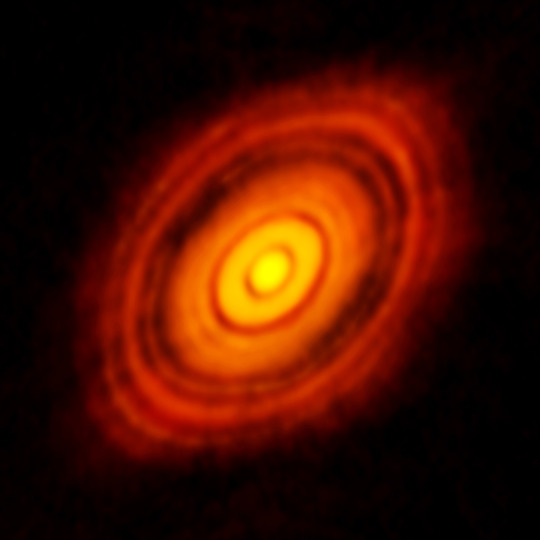
That dust globs together into larger and larger pieces, and eventually forms hundreds of "planetesimals", which are rocky bodies about a kilometer across. Planetesimals had very erratic orbits compared to the modern planets - the dust of the protoplanetary disk caused friction and drag, which threw them off course.
They frequently collided with each other, and either broke apart or stuck together and grew even larger. Arrokoth is actually a leftover planetesimal, a time capsule from the early solar system, and we were able to visit it wayyy out in the Kuiper belt with the New Horizons probe!
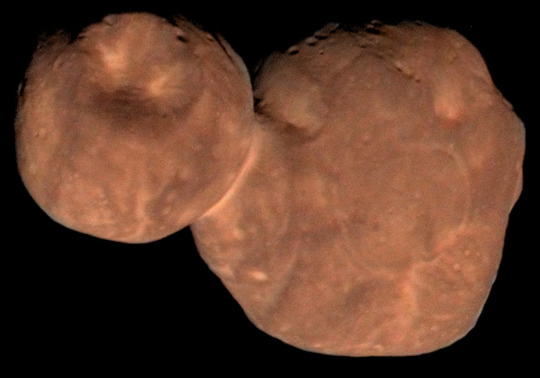
Once planetesimals get to be about the size of the moon, we call them "protoplanets". Protoplanets were fundamentally different from their planetesimal siblings - we believe they were differentiated. When an object in space gets big enough, a combination of radioactive decay, impacts, and gravitational pressure causes them to heat up and melt. Denser materials like iron and nickel sink towards their centers, while the lighter materials rise to the surface. The differentiation process is why Earth's core is made of iron, while the surface is primarily rock.
While protoplanet orbits were much more stable than those of planetesimals, they still eventually collided with each other until everything settled into the planets we see today (though gas giants had a few extra steps - that's a different post!).
We think the Psyche asteroid was a protoplanet, well on its way to becoming a bona fide planet, when an impact struck it hard enough to strip away its rocky layers, leaving behind the dense, metallic core - like in this illustration.
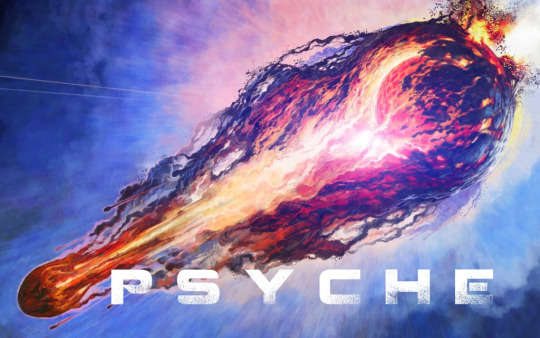
More and more, we think the properties of a planet's core are fundamental to its long-term evolution. Venus, Earth, and Mars are all roughly the same size and roughly the same distance from the sun, cosmically speaking, yet they're so different! Venus has hell death clouds, Earth is home, and Mars is dry and dead - why?
The Psyche asteroid gives us the unique opportunity to actually observe a planetary core directly - it's much harder to dig to the center of a planet than it is to go to space, so that's exactly what we're going to do!
On Thursday October 12th at 10:16am Eastern, the Psyche spacecraft will launch and begin its journey to the asteroid belt! You can watch at https://www.nasa.gov/nasatv/!

I've been a part of this mission for over four years now, and I can't speak highly enough of the team that made it happen through all of the ups and downs. Good luck out there, buddy. We're all rooting for you :')
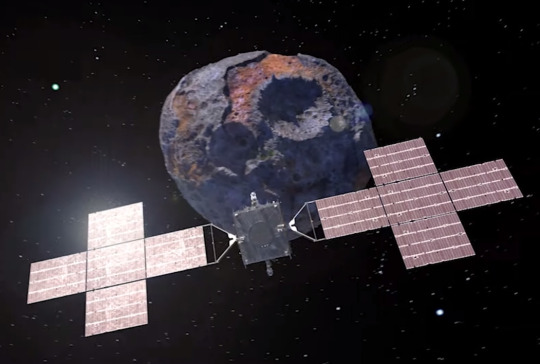
#space#NASA#psyche#asteroid#planet#psyche mission#long post#get home safe friend#you're gonna see some amazing things#For real y'all this mission has been my every single day for the past four years#I grew up with this project#end of an era but beginning of something new!#spost
380 notes
·
View notes
Note
I have heard some people say there is credible evidence for the idea of planet X. What I have seen people say is that the structure of our solar systems planetary relationship makes no sense and that there is a missing planet that would make it all make sense. Much like a shadow of sorts for something that science would almost demand the presence of or at least so I have heard. Do you feel like this is true or have people figured something else out and I'm reading hog wash? (feel free to not answer this if its just a lil too fringe subject for your area of knowledge)
Yes, there is evidence that there may be another planet in the solar system, one of the reasons is regions in the Kuiper belt and Oort cloud where there is a lack of objects such as asteroids and comets, where a planet would possibly have passed during its orbit around the sun… but we are still not sure.
34 notes
·
View notes
Text
Pluto may have been kicked out of the Planet group, but know that they are now the King of the Kuiper Belt/Oort Cloud and all Dwarf Planets, so really, who's laughing now?
the thing about the godawful "pluto will always be a planet IN MY HEART UnU" narrative is. why does this hypothetical anthropomorphic Pluto want to be a planet
like if i'd never fit in with all the other planets no matter how hard i tried and then someone finally realized "hey! its not fair to hold you to the standards of something you aren't! we know what you are now! we understand you better, you never have to be labeled as something you're not again!" that would be like the happiest ending possible
like science isn't nostalgia its constantly changing as we learn more and more about how the universe works, and change isn't always bad
but also like i fail to see how this is sad for pluto
#it actually fits because in greek/roman myths Hades/Pluto was kind of an outcast being the Kind of the Underworld#he basically got the short end of the stick#(literally. Zeus/Jupiter Poseidon/Neptune and Hades/Pluto drew lots to see what their domains would be)#(with Zeus getting the sky Poseidon with the sea and Hades with the Underworld)#the Kuiper Belt is where Pluto is it's a large area where comets come from and most icy objects further out from Neptune#think of it as the Asteroid Belt but with freezing temperatures (well space is cold but still! Really far from the sun here!)#And the Oort Cloud is much bigger colder and further out! A massive area of just cold and dark (full light year to even reach the beginning#there's so many unknown plants that could be out here actually!#We know Eris and I think there's another one named Sedna!#the Oort Cloud is basically the edge and end of our solar system and beyond that is where Heliopause happens#(where the solar winds are met with interstellar ones)#Fun fact! Voyager 1 has gone beyond the Heliopause in 2012 marking it the first human object to do so!#it's still within the confines of the solar system mind you! it'll take another 300 years to even hit the Oort Cloud#still can't believe those fuckers are still transmitting data#well I mean#Voyager 1 is but 2's antenna accidentally pointed away from Earth by 2 degrees this year in August#it's still working but we won't be getting data anytime soon#it's just too far away#space#just rebloging#Don't worry about getting sentimental over a planet#I'm over here on the verge of tears for two very old spacecraft that'll probably never Earth again
4K notes
·
View notes
Note
can u tell me an astrophysics fun fact pls!!! :3
So the reason why Pluto was suddenly up for debate as a planet or not in 2005 with the discovery of Eris, another dwarf planet that's almost the same size as Pluto. If Pluto is a planet, why couldn't Eris? For a while that was debated until it was decided sometimes in 2006 that Eris was not a true planet.
After this, other objects were discovered in the Kuiper belt (and one in the asteroid belt--Ceres!!) that were too large to be considered asteroids. If all these objects could be considered planets, our whole understanding and definition of how planets behaved would be changed, and there would be 13 planets in our solar system. So the scientists said that would be too complicated and put them all in their own special category
So yeah that's why Pluto's not a planet :P
49 notes
·
View notes
Text
“If we make Pluto a planet we have to make all the objects in the Kuiper belt planets”
That’s fine with me we can brag to alien that our solar system has over a 100 planets
84 notes
·
View notes
Text

Heliosphere: Under the Sky
Meet the dwarf planet, Ceres! Unlike most dwarf planets, she lives in the Asteroid Belt.
Ceres was discovered back in 1 January 1801. She was designated as an asteroid back then, until she was promoted to dwarf planet status back in 2006 along with the discoveries of other objects in the Kuiper Belt with similar characteristics as her.
Ceres (NASA page)
#art#gijinka#personification#solar system#dwarf planets#ceres#finally she has a new picture... i was dying to make one for her now that i'm starting to develop her more!#so apparently she's a ranger#and she tries her best to maintain the peace in the asteroid belt#that baton thing she's holding? it can transform into any weapon. she's a weapons master#i think she likes long range weapons the most but i'll still have to see. i have a lot of reading to do for ceres anyway#and the asteroid belt for that matter#i just really want her to be the smallest but packed with power in a way. she has to be tough#she does live closer to the planets after all and she wants to stay strong having to deal with them daily unlike the other dwarf planets#tag commentary
29 notes
·
View notes
Text
WHY IS THE SPACE BLACK??
Blog#306
Saturday, June 17th, 2023
Welcome back,
Look up at the night sky with your own eyes, or marvel at images of the universe online, and you'll see the same thing: the inky, abysmal blackness of space, punctuated by bright stars, planets or spacecraft. But why is it black? Why isn't space colorful, like the blue daytime sky on Earth?
Surprisingly, the answer has little to do with a lack of light.
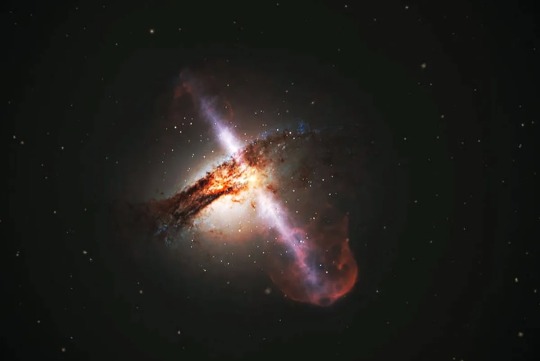
"You would think that since there are billions of stars in our galaxy, billions of galaxies in the universe and other objects, such as planets, that reflect light, that when we look up at the sky at night, it would be extremely bright," Tenley Hutchinson-Smith, a graduate student of astronomy and astrophysics at the University of California, Santa Cruz (UCSC), told Live Science in an email. "But instead, it's actually really dark."

Hutchinson-Smith said this contradiction, known in physics and astronomy circles as Olbers' paradox, can be explained by the theory of space-time expansion — the idea that "because our universe is expanding faster than the speed of light … the light from distant galaxies might be stretching and turning into infrared waves, microwaves and radio waves, which are not detectable by our human eyes."

And because they are undetectable, they appear dark (black) to the naked eye.
That said, a 2021 study in The Astrophysical Journal suggests that space may not be as black as scientists originally thought. Through NASA's New Horizons mission to Pluto and the Kuiper Belt, researchers have been able to see space without light interference from Earth or the sun.

The team sifted through images taken by the spacecraft and subtracted all light from known stars, the Milky Way and possible galaxies, as well as any light that might have leaked in from camera quirks. The background light of the universe, they found, was still twice as bright as predicted.
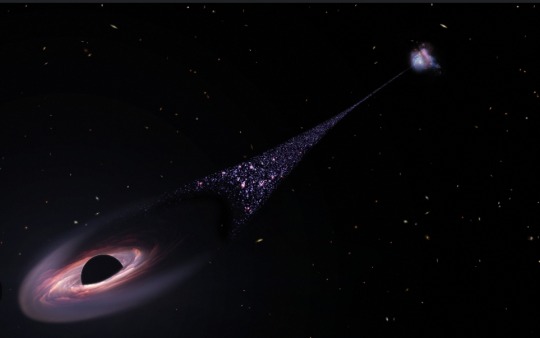
The reasons for the additional brightness, which remain unknown, will be the focus of future studies. Until then, one thing seems likely: Space could very well be more "charcoal" than pitch-black.
Originally published on big livescience.com
COMING UP!!
(Wednesday, June 21st, 2023)
"WHY IS DARK MATTER SO IMPORTANT??"
#astronomy#outer space#alternate universe#astrophysics#spacecraft#universe#white universe#parallel universe#space#astrophotography
308 notes
·
View notes
Note
... did the IAU only find out that Pluto didn't clear its orbit in 2006, making them realize that it actually wasn't a planet after all? What was the new discovery that ended up showing that their definition of a planet was completely inadequate?
it was a series of discoveries from 1992 to 2005 that led to the decision, but in particular the discovery of Eris, an object more massive than Pluto in the same belt of trans-Neptunain objects that Pluto is in.
I don't think the way "clearing the orbit" is usually explained is very helpful for getting laypeople to understand what it means. it does sound kinda arbitrary if you just look at the official definition without first fully getting why it's a concept useful enough to come up with a definition for it.
the Solar System can be thought of as being divided into these "bands". some of these bands have one large object in them that gravitationally dominates the entire band. anything else in these regions of the Solar System either has an orbit directly influenced by that large object, or doesn't have a stable orbit at all. (there's a lot of confusion about this point. "clearing the orbit" does not mean the area around the object's orbital path is empty, it means that anything that is in the orbital path is either unstable or has an orbit that's directly influenced by the object in question.)
however, there are other regions of the Solar System between the regions dominated by these large bodies where there are many many smaller objects with orbits that all cross each other and don't significantly impact one another. the first of these that was discovered was the asteroid belt between Mars and Jupiter. the Kuiper Belt, where Pluto is, is another example.
so, in the study of the dynamics between objects in the Solar System (this is one of the primary things the field of astronomy does), it's useful to have a single convenient word for "object which gravitationally dominates all the other objects in its associated region of the Solar System", and in 2006, it was decided by a vote in the IAU that the word "planet", which until that point didn't have a very strictly defined definition (it was, at best, a catchall category for anything that went around the Sun that didn't belong to any other category), would be used to refer to that concept.
and as I've said before, using a common word to refer to a highly specific concept for technical purposes is completely normal. every single field of study does this. the other uses of the word "planet" still exist, but in a classification system, it's important for people to agree what the classifications themselves mean, and the technical definitions that are established should be useful to the field of study that they are made for.
so, to answer the actual question. the realization that Pluto doesn't clear its orbit happened gradually over the course of about a decade. we realized that, in terms of its role in the dynamics of the Solar System, it is more useful to group Pluto in with the other trans-Neptunian objects in the Kuiper Belt than it is to group it in with the planets, and that there are a lot of Pluto-like objects in the Kuiper Belt.
305 notes
·
View notes
Text
"something ricked this way comes" is one of my less-liked r&m episodes partly because of the r-slur exchange but mostly because my inner astronomy nerd always yells at the screen "THAT'S NOT WHY PLUTO ISN'T A PLANET, PLUTO ISN'T A PLANET BECAUSE ITS ORBIT INTERSECTS WITH THE ORBIT OF NEPTUNE AND THE FORMAL DEFINITION OF A PLANET REQUIRES THAT IT CLEAR EVERYTHING ELSE IN ITS ORBIT, AS THE ALTERNATIVE WAS HAVING TO ADD 2574378755896435637013 KUIPER BELT OBJECTS TO THE LIST OF PLANETS IN THE SOLAR SYSTEM, IT HAS NOTHING TO DO WITH PLUTO'S SIZE AT ALL!"
however, i will always repost rick and summer beating up nazis. it is always correct to repost rick and summer beating up nazis
60 notes
·
View notes